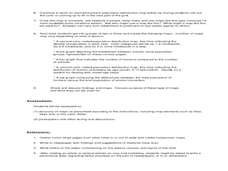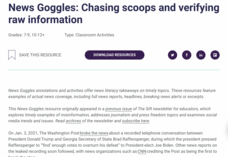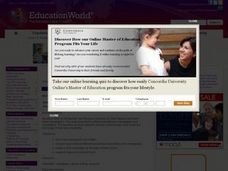Newseum
Journalists Code of Ethics
Journalists are supposed to adhere to a Code of Ethics. To determine the degree to which reporters follow this code, individuals select three recent stories with photographs from newspapers, magazines, online news sites, or television...
Curated OER
Comparing Plans
Good consumer practices such as price comparison can make or break a budget. Youngsters research five different cell phone carriers and the plans they offer. They compile their data and determine which plan offers the best value. They...
Newseum
Persuasion Portfolios
After class members brainstorm a list of current social and political issues, groups each select a different topic from the list to research. Teams create a portfolio of at least 10 examples of stories about their issue, stories that...
Stanford University
Pullman Strike
History is ironic, isn't it? In the Pullman strike, federal power thought to protect citizens was used to break the union. What started as a quest for better wages and benefits during an economic crisis was crushed through violence and...
Alabama Department of Archives and History
Yellow Journalism
What role did yellow journalism play in bringing the United States into war with Spain? As part of their study of the Spanish-American War, class groups examine newspapers of the times and other texts and then produce their own...
Nemours KidsHealth
Alcohol: Grades 9-12
Two activities ask high schoolers to consider the role of alcohol culture in their lives. First, groups analyze the types of appeals used in newspaper ads for alcoholic drinks and compare those images with what they have observed....
Curated OER
From Printed Page to Home Page
Students compare on-line newspapers to their print counterparts
Curated OER
What is the Population Distribution of Cartoon Characters Living On the Pages of Your Newspaper?
Students read various cartoons in their local newspaper and calculate the population demographics, spatial distribution and grouping of the characters. Using this information, they create a population distribution map and share them with...
Curated OER
Abbreviations and Acronyms in Newspapers
Learners investigate the purpose and meaning of common abbreviations and acronyms by examining them in newspapers.
Curated OER
Compare and Contrast Culture
Fifth graders compare and contrast the cultures of American culture with that of the other cultures of North America. Using traditional and Internet research, 5th graders gather data on one element of culture for comparison. Data...
Curated OER
Comparing the Ancient and Modern Olympics: A Venn Diagram
Students compare and contrast today's Olympic Games to those held in ancient Greece. They read newspapers, conduct Internet research, watch TV coverage of current Olympic Games and organize their findings on a Venn diagram.
Curated OER
Comparing Monkey Story with Curious George Stories
Students compare and contrast the main character in Monkey with the main character in Curious George.
Curated OER
Newspapers in Education-Sampling Italian Foods
Young scholars use the food and entertainment section of the newspaper to find Italian restaurants in their area. They write a letter to one of the restaurants asking the restaurant to bring some sample dishes to their classroom for a...
Curated OER
Presidential endorsements: Newspapers decide
Twelfth graders collect, organize, evaluate and synthesize information from multiple sources in order to draw logical conclusions. They communicate this information using appropriate social studies terminology in oral, written or...
Curated OER
Comparing Good and Bad Character Traits of Historical and Current Figures
Young scholars create a chart with two columns. In one column include good and bad character traits of historical figures in biographies and historical fiction. In the second column include good and bad character traits of current famous...
Curated OER
Introduction to Canada
Ninth graders investigate the country of Canada by examining their media in this geography lesson. They use the Internet to research Canadian newspapers and analyze a topic covered by both US and Canadian media sources. After comparing...
National Park Service
News Bearly Fit to Print
There are an average of three human fatalities by bears in North America every year, which is low when you compare it to the 26 killed by dogs and the 90 killed by lightning annually. The lesson encourages researching human-bear...
Curated OER
Finding Promise in Compromise
Examine how the 'safe passage' for Palestinians between the Gaza Strip and the West Bank affects those living in Israel and reflects both conflict and cooperation between the Israelis and Palestinians. The class compares the perspective...
Curated OER
Changes In The New Nation: New Beginnings
Students consider the role of American newspapers in the revolution and plans for new government. In this early American history lesson, students determine how communication provided by newspapers contributed to the organization of the...
EngageNY
Revising the Newspaper Article: Sentence Structure and Transitions
Take two. After a mini lesson covering sentence structure and transition words, scholars revise their End of Unit 3 Assessment based on feedback. Writers self-score their assessments against row three in the Newspaper Article Rubric.
News Literacy Project
News Goggles: Chasing Scoops and Verifying Raw Information
A 23-slide presentation teaches young media analysts how to identify a scoop or exclusive first report of a breaking story, how these reports become verified, and how subsequent reports in other news sources add information or refocus...
Curated OER
Not Getting the News about the Stamp Act
How did American colonists react to the Stamp Act of 1765? Your young historians will examine primary source material by reading excerpts from a transcription of the Pennsylvania Gazette and then identifying the sentiments expressed by...
Curated OER
Writing Newsletters!
A reading of Gail Gibbons’ Deadline! leads to a discussion of the differences between newspapers and newsletters. Class members then choose a favorite topic and create the front page for their own newsletter.
Curated OER
Information Overload: Looking at News
How do events reported in mainstream newspapers, on television news, blog posts, and social network sites differ? Ask your class to investigate the way the same news item is presented in the many information sources available. Groups...

























